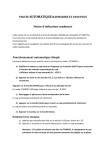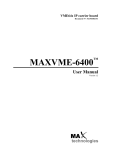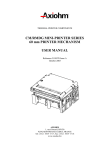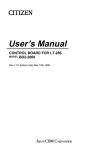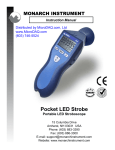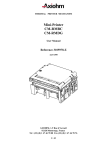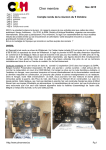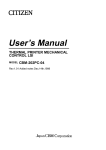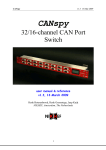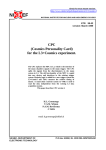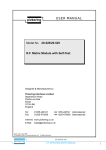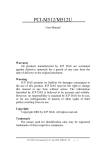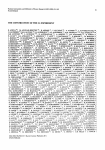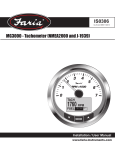Download nimrod - High Energy Physics
Transcript
NIK HEF NATIONAL INSTITUTE FOR NUCLEAR AND HIGH ENERGY PHYSICS ETR 99-06 NIMROD, 16 channel read out driver for the Drift Chambers used in the L3+Cosmics project. September 1999 Project no.: 32010 H.L.Groenstege P.A.M. Rewiersma T.A.M. Wijnen A.N.M. Zwart email: [email protected] The NIKHEF MDT read out driver is a VME module that collects data from the TDCs, connected to the Drift Chambers. The data from several MDT chambers is merged and can be read by a VME master Check for most recent version: http://www.nikhef.nl/pub/departments/et/L3/cosmics NIKHEF, DEPARTMENT OF ELECTRONIC TECHNOLOGY P.O.box 41882, NL 1009 DB AMSTERDAM DRAFT VERSION 1.0 NIMROD 09-09-1999 Table of contents 1. 1.1 NIMROD NIMROD connections 3 4 2.1 2.2 2.3 2.4 General description Block diagram Frontend FIFO Event memory VME Interface 7 7 7 8 8 3.1 3.2 Data format Data format of a channel input Event Data format of the NIMROD 10 11 11 4. Connector pinout 11 5. Abbreviations 15 2. 3. Figures Figure 1: NIMROD modules Figure 2: NIMROD connections Figure 3: NIMROD front Figure 4: Block Diagram Figure 5: Base address 3 4 5 6 8 2 DRAFT VERSION 1.0 NIMROD 09-09-1999 1. NIMROD The NIMROD (NIKHEF MDT Read Out Driver) concentrates the data from a number of TDCs1 into a single output register. The unit receives trigger and clock from the CTP (Central Trigger Processor) and distributes this to the TDCs. In the L3 + Cosmics project the function of the CTP is fulfilled by the CTT-V2 (Cosmics Trigger and Timing module)2 and the TDCs are interfaced to the NIMROD on a CPC (Cosmics Personality Card)3. A complete NIMROD consists of a set of modules; a NIMROD, a NIMROD_fanout module and four patchpanel boards. The NIMROD is a standard 6U * 160 mm VME module. Several NIMRODs may share a VME crate, controlled by a single master. This controller reads the event data and takes care of various settings in the NIMRODs. Figure 1: NIMROD modules 1 A 24 channel TDC for the ATLAS precision muon chambers, Y. Arai (KEK) J. Christiansen (CERN). ETR 99-01: Cosmics Trigger and Timing Module, H. Verkooyen //www.nikhef.nl/pub/departments/et/L3/cosmics/. 3 ETR 99-02: Cosmics Personality Card, H Groenstege et all //www.nikhef.nl/pub/departments/et/L3/cosmics/ 2 3 DRAFT VERSION 1.0 NIMROD 09-09-1999 Figure 2: NIMROD connections 1.1 NIMROD connections Each NIMROD accepts a maximum of 16 FELinks (Front-End Links) via the NIMROD_ Fanout module and a patch panel. The FELink connector is a standard shielded RJ45 and the cable is a shielded CAT 5 network cable. The NIMROD_fanout module is connected to the NIMROD via row a and c of the VME P2 connector. It connects the TDCs to the NIMROD inputs and multiplexes the trigger and reset signals to the TDCs. The VME interface is used to control the NIMROD, read the event data and generate test triggers and test resets. 4 DRAFT VERSION 1.0 NIMROD 09-09-1999 On the frontpanel are two 10-pin connectors. The upper connector, labeled Test, is a JTAG port used to perform in system programming of the FPGAs on the NIMROD. The lower connector, labeled Trigger, must be connected to the CTP via the trigger bus to receive the 40 MHz TDC clock, the coded trigger and reset signals and to return the inhibit trigger signal. The signal levels are differential Positive ECL and must be terminated with 100 Ohm after the last NIMROD. The combined inhibit trigger signals from the NIMRODs are terminated in the CTP. The coding of the trigger/reset signals on three sequential clock pulses is as follows: 1, 0, 0 = >Trigger 1, 0, 1 = > Event Counter Reset (ECR) 1, 1, 0 = > Bunch Counter Reset (BCR) 1, 1, 1 = > Global Reset Due to coding of the Trigger and Reset internal in the NIMROD the maximum trigger frequency is the system clock divided by three. This is 20MHz/3 = 6.7 MHz (so the minimal deadtime is 150ns) . All FELink signals to or from the TDCs are Low Voltage Differential Signals (LVDS). The serial data from the TDCs is received via two differential lines using DS coding without handshaking. The data consist of a startbit, followed by 32 bit TDC data, a paritybit and a stopbit. The rate on this connection is 40 Mbit/s. The two signals from the NIMROD to the TDCs are also distributed via differential lines: • The 40 MHz TDC clock. All signals are synchronous to this clock. • The coded trigger/reset signal. Which is the trigger/reset signal from the CTP after a delay of four clock pulses. For test purposes the NIMROD mode register can also generate this signal. Figure 3: NIMROD front 5 Figure 4: Block Diagram DRAFT VERSION 1.0 NIMROD 09-09-1999 2. General description 2.1 Block diagram The trigger and reset from the CTP is decoded in the Trigger and Reset Decoder. The coded signals are distributed to the TDCs via the FELinks. The Global Reset is used internally to reset all counters and FIFOs in the NIMROD; the Event Counter Reset only clears the Event Counter in the Header block and the Bunch Counter Reset is not used in the NIMROD. On a trigger, the Event Counter in the Header block is incremented and the data is stored in a circular buffer in the Event Memory. The address is stored in the Look Up Table (LUT) to be used for read out. Then, if the header enable bit is set, a flag header word (0x18100000) is stored, hereafter the flags are read and stored on the next addresses. When the circular buffer or the LUT is full, writing is inhibited and the triggers are stored in the Frontend FIFO. Simultaneously the TDCs will sent data via the FELinks to the NIMROD. This data is converted from serial to parallel (32 bit) and stored into a FIFO. The data is read from the FIFO. If it is a leader of an event (Begin Of Group), the start address of the event is stored in the LUT. On the next address the Begin Of Group word is stored in the memory, followed by the next word from the FIFO until the trailer of the event (End Of Group) is detected. Then the Channel Header word is stored in the memory on the begin address of the event. When there is no data between the Begin Of Group (BOG) and End Of Group (EOG), the Event Empty bit is set in the Channel Header. After the writing of the Channel Header the event-present counter is incremented. If the event-present counter is not equal to zero, the event present flag of this channel is asserted. When all channels have an event present, the Read-Out block starts a read-out cycle. At this point the Header block and the enabled channels get the read addresses from the LUTs, the Header block reads the Begin Of Event from the memory and puts it in the Output Register in the VME interface. Then Read-Out waits for the VME Master to read the output register before it enables the Header block to get the next word. If the Header block has read the data of the event it decrements its event-present counter and enables the first enabled channel to read the data until the read address is equal to the next address in the LUT or equal to the write address. Then the channel decrements its event counter and enables the next channel to send its data. This continues until all channels have read the event data from the memory. The Read-Out now terminates the read-out cycle and writes the End Of Event in the Output Register. If the Read-Out detects an Empty Event bit in a Channel Header, it will skip this channel, thus performing a zero-suppressed read-out. This zero-suppress is bypassed on event 1 modulo 0x1000 events. The data rate of the Read-Out via VME is 6 MB/sec (670 ns/word). 2.2 Shift Register The serial data from the TDCs with LSB first is shifted in this register, if the last bit (MSB) is shifted in, the parity is checked. When the parity is not correct, the Serial Error Flag is asserted and the Serial Error bit (bit 26) is set in the TDC data. Then the data is loaded in the Frontend FIFO. The serial error flag will be cleared when the flag word is written in the Event memory. 2.3 Frontend FIFO The data in the event memory is written by 18 sources (16 Channels, the Header and the VME interface). These sources are scheduled with the system clock. Therefore a 64 words deep Frontend FIFO is implemented for every channel to store the data which is not yet written in the Event Memory. To prevent the FIFO to overrun an inhibit trigger is generated when the FIFO is half full (32 words). The inhibit trigger is released when the FIFO is empty. The input rate of the shift register is 35 bits @ 40 MHz. This results in an input rate of the FIFO of 1.14 MHz (875 ns) per word. With a system clock of 20 MHz the output rate is1.11 MHz (20 divided by 18), which is almost the same as the input rate. 7 DRAFT VERSION 1.0 NIMROD 09-09-1999 So the FIFO will only be filled when the write to memory is inhibited by a memory full or a LUT full condition. The system clock of the first version NIMROD was 7.5 MHz., So the output rate of the FIFO was 0.41 MHz. (2.44 µs) which is much lower than the input rate. Therefor a mechanism is built in that when the FIFO is almost full (56 words) only the Begin Of Group and End Of Group words are stored in the FIFO. This to prevent corruption of the bookkeeping of the event fragments. 2.4 Event memory The event memory is a synchronous ZBT RAM that does not need the deselect cycle between a write and a read cycle. The memory clock is 40MHz; this enables a write and a read during one system clock cycle. The memory has 17 circular buffers of 2K 32-bit words, one for every Channel plus the Header. For debugging purposes the memory is accessible from VME, the address map is given in the next chapter. 2.5 VME Interface The VME Interface is compliant to VME64x and all devices can be accessed in the A24D32 and A32D32 addressing modes. The base address is defined by the Geographical Address pins on the backplane connector. In case the backplane does not support geographical addressing, jumpers J54 (= Ga0) to J50 (= Ga4) should be installed to define the base address of the NIMROD. If no jumpers are installed and no geographical addressing is supported, the default value of Ga(4:0) = 0x4. Figure 5: Base address Valid Address Modifier codes are 0x09 and 0x0D for A24D32 transfers, 0x39 and 0x3D for A24D32 transfers and 0x2F for accessing of the Configuration ROM (CR) and Control & Status Register (CSR). The Configuration ROM is a 64 x 8 bit ROM that contains module identification data. The ROM addresses are mapped in the VME address space from address offset 0x03 to 0xFF on every fourth byte. 8 DRAFT VERSION 1.0 NIMROD 09-09-1999 The Control & Status Register: Bit 7 Bit 4 Bit 3 Bit 7 Bit 4 Bit 3 1 0 1 0 1 0 Control & Status Bit Set Register, address offset = 0x7FFFB On Writes On Reads put module in reset mode 1 module is in reset mode no effect 0 module is not in reset mode enable module 1 module is enabled no effect 0 module is disabled no effect 1 module generated BERR no effect 0 module did not generate BERR Control & Status Bit Clear Register, address offset = 0x7FFFC On Writes On Reads 1 remove module from reset mode 1 module is in reset mode 0 no effect 0 module is not in reset mode 1 disable module 1 module is enabled 0 no effect 0 module is disabled 1 clear BERR bit 1 module generated BERR 0 no effect 0 module did not generate BERR The module reset can be done in two ways: 1. A short reset; Global Reset or bit 7 in CSR is asserted not longer then 16 system clock cycles. Resets all counters and FIFOs 2. A long reset; bit 7 in CSR is asserted longer then 16 system clock cycles. This reset does the same as a short reset, but also clears the LUTs. After this reset one has to wait for 786 system clock cycles for the clear LUT to complete. The Mode Register: Bit 7 Bit 3 Bit 2 Bit 1 Bit 0 1 0 1 0 1 0 1 0 1 0 Mode Bit Set Register address offset = 0x7FFF3 On Writes On Reads enable interrupt 1 interrupt is enabled no effect 0 interrupt is disabled Generate bunch reset 1 bunch reset generated no effect 0 no bunch reset generated Generate event reset 1 event reset generated no effect 0 no event reset generated Generate global reset 1 global reset generated no effect 0 no global reset generated Generate trigger 1 trigger generated no effect 0 no trigger generated 9 DRAFT VERSION 1.0 1 0 1 0 1 0 1 0 1 0 Bit 7 Bit 3 Bit 2 Bit 1 Bit 0 NIMROD 09-09-1999 Mode Bit Clear Register address offset = 0x7FFEF On Writes On Reads Disable interrupt 1 interrupt is enabled no effect 0 interrupt is disabled clear bunch reset bit 1 bunch reset generated no effect 0 no bunch reset generated clear event reset bit 1 event reset generated no effect 0 no event reset generated clear global reset bit 1 global reset generated no effect 0 no global reset generated clear trigger bit 1 trigger generated no effect 0 no trigger generated The Event Memory has an address offset of 0x40000. On this address the 8KB cyclic buffer of channel 0 starts, channel 1 starts at 0x42000 etc… until the buffer of the header that starts at 0x60000. The Flags words are read-only and the address offsets are: 0x200 0x204 0x208 0x20C event present inhibit LUT full memory full 0x210 0x214 0x218 0x21C FIFO empty FIFO half full channel enable serial error Except for the channel enable, the flags are read-only. Bit 16 of the flag words is the header flag, bit 15 to 0 are the flags of channel 15 to 0. Reading of the flags should not be done when the trigger is enabled, this corrupts the flag words in the event data. The readout register is mapped to multiple addresses to enable block- or DMA transfers; the address offset is 0x300 to 0x1000. Reading the readout register when there is no event present will return 0x0. The interrupter is of a single level type. An interrupt is generated when the interrupt enable is set in the mode register and the event present flags of all enabled channels are set. The interrupt request level is set in the interrupt request register at address offset 0x110. If bit 1 is set, the interrupt level is 1, if bit 2 is set, the interrupt level is 2, and so on until bit 7 then the interrupt level is 7 (bit 0 is not used). Only one bit must be set in the interrupt request level register. After reset the default interrupt request level is 2. The interrupt vector is set in the interrupt vector register at address offset 0x114. 3. Data format The description below gives a summary of the data format that the NIMROD uses. The data format is compliant to the L3 Cosmics data format4. It should be noted that the NIMROD only tests on BOG and EOG for administration purposes and that all incoming data appears in the event data. 4 KUN internal note, HEN425, The L3+Cosmics Data format, Thei Wijnen et all //www.hef.kun.nl/l3c/ 10 DRAFT VERSION 1.0 NIMROD 09-09-1999 3.1 Data format of a channel input Description Bit 31 - 28 Bit 27 - 24 Begin Of Group TDC data More TDC data End Of Group 1010 0011 0011 1101 0100 Bit 23 - 20 Bit 19 - 16 Bit 15 - 12 Bit 11 - 8 ECNT Bit 7 - 4 Bit 3 - 0 Card ID TDC data TDC data 0101 ECNT Group WCNT 3.2 Event Data format of the NIMROD Description Bit 31 - 28 Bit 27 - 24 Begin Of Event Flag Header* LUT full flags* Memory full flags* FIFO half full flags* Serial error flags* Channel Header Begin Of Group TDC data 1000 0001 0001 0001 0001 0001 0001 1010 0011 0000 1000 1001 1001 1001 1001 1000 0100 More TDC data 0011 End Of Group Channel Header Begin Of Group TDC data 1101 0001 1010 0011 More TDC data 0011 End Of Group End Of Event 1101 1111 Bit 23 - 20 0000 0000 0001 0010 0011 0001 S E S E 0101 1000 0100 Bit 19 - 16 Bit 15 - 12 Bit 11 - 8 Bit 7 - 4 ECNT (24bits) 0000 0000 0000 0000 000x xxxx xxxx xxxx 000x xxxx xxxx xxxx 000x xxxx xxxx xxxx 000x xxxx xxxx xxxx 000E 0000 Channel ID ECNT Card ID TDC data Bit 3 - 0 0000 xxxx xxxx xxxx xxxx TDC data 0000 S E S E 0101 ECNT 000e ECNT 0000 Group WCNT Channel ID Card ID TDC data TDC data ECNT Event WCNT Group WCNT The ‘E’ bit in the channel header is the Empty Event flag. The ‘SE’ bit in the TDC data is the Serial Error flag detected by the NIMROD. 4. Test points and Jumpers settings The NIMROD has 4 test points (TP1 to TP4) next to the memory chip IC17 and one test point (TP5) next to the Trigger Connector. TP1 to TP4 are connected to the memory control signals, TP5 is connected to pin 10 of the trigger connector and is not used. * The flag words and header are inserted in the event data if bit 16 is set in the channel enable flag word. 11 DRAFT VERSION 1.0 TP1 TP2 TP3 TP4 TP5 NIMROD 09-09-1999 Memory Chip Select Memory Clock Write Enable Output Enable not used The user definable jumpers are the address jumpers (J50 to J55) and the 3V3 power select jumper (J5). If J5 pos. 1 is connected, the 3V3 power is obtained from the backplane, if pos 2 is connected, the 3V3 is coming from the on board power regulator. When the NIMROD is connected to a VME64x compatible backplane, all the address jumpers should be removed and J5 can be either in pos 1 or 2. In all other cases the address jumpers should be installed and J5 pos. 2 connected. 5. Connector pinout Trigger Pin 10 8 6 4 2 Signal NC Trigger/Reset (-) GND Clock (-) GND Pin 9 7 5 3 1 Signal GND Trigger/Reset (+) GND Clock (+) Trigger Disable Test Pin 10 8 6 4 2 Signal NC GND +5V GND NC Pin 9 7 5 3 1 Signal NC TDO TDI TMS TCK Channel input Pin Signal 1 Clock(+) 2 Clock(-) 3 Trigger/Reset(+) 4 Data(-) 5 Data(+) 6 Trigger/Reset(-) 7 Strobe(+) 8 Strobe(-) 9 GND 10 GND 12 DRAFT VERSION 1.0 VME P1 Pin Row z 1 NC 2 GND 3 NC 4 GND 5 NC 6 GND 7 NC 8 GND 9 NC 10 GND 11 NC 12 GND 13 NC 14 GND 15 NC 16 GND 17 NC 18 GND 19 NC 20 GND 21 NC 22 GND 23 NC 24 GND 25 NC 26 GND 27 NC 28 GND 29 NC 30 GND 31 NC 32 GND NIMROD Row a D0 D1 D2 D3 D4 D5 D6 D7 GND NC GND DS1_N DS0_N WRITE_N GND DTACK_N GND AS_N GND IACK_N IACKIN_N IACKOUT_N AM4 A7 A6 A5 A4 A3 A2 A1 NC +5V Row b NC NC NC BG0IN_N BG0OUT_N BG1IN_N BG1OUT_N BG2IN_N BG2OUT_N BG3IN_N BG3OUT_N NC NC NC NC AM0 AM1 AM2 AM3 GND NC NC GND IRQ7_N IRQ6_N IRQ5_N IRQ4_N IRQ3_N IRQ2_N IRQ1_N NC +5V 09-09-1999 Row c D8 D9 D10 D11 D12 D13 D14 D15 GND NC BERR_N SYS_RES_N LWORD_N AM5 A23 A22 A21 A20 A19 A18 A17 A16 A15 A14 A13 A12 A11 A10 A9 A8 NC +5V Row d NC NC NC NC NC NC NC NC GAP_N GA0_N GA1_N 3V3 GA2_N 3V3 GA3_N 3V3 GA4_N 3V3 NC 3V3 NC 3V3 NC 3V3 NC 3V3 NC 3V3 NC 3V3 NC NC 13 DRAFT VERSION 1.0 VME P2 Pin Row z 1 NC 2 GND 3 NC 4 GND 5 NC 6 GND 7 NC 8 GND 9 NC 10 GND 11 NC 12 GND 13 NC 14 GND 15 NC 16 GND 17 NC 18 GND 19 NC 20 GND 21 NC 22 GND 23 NC 24 GND 25 NC 26 GND 27 NC 28 GND 29 NC 30 GND 31 NC 32 GND NIMROD Row a GND SER_DATA0 SER_DATA1 GND SER_DATA2 SER_DATA3 GND SER_DATA4 SER_DATA5 GND SER_DATA6 SER_DATA7 GND SER_DATA8 SER_DATA9 GND SER_DATAA SER_DATAB GND SER_DATAC SER_DATAD GND SER_DATAE SER_DATAF GND GND GND GND GND CPCTRST NC NC Row b +5V GND NC A24 A25 A26 A27 A28 A29 A30 A31 GND +5V D16 D17 D18 D19 D20 D21 D22 D23 GND D24 D25 D26 D27 D28 D29 D30 D31 GND +5V 09-09-1999 Row c GND SER_STRB0 SER_STRB1 GND SER_STRB2 SER_STRB3 GND SER_STRB4 SER_STRB5 GND SER_STRB6 SER_STRB7 GND SER_STRB8 SER_STRB9 GND SER_STRBA SER_STRBB GND SER_STRBC SER_STRBD GND SER_STRBE SER_STRBF GND GND GND GND GND CPCTRCLK NC NC Row d NC NC NC NC NC NC NC NC NC NC NC NC NC NC NC NC NC NC NC NC NC NC NC NC NC NC NC NC NC NV NC NC 14 DRAFT VERSION 1.0 NIMROD 09-09-1999 6. Abbreviations Abbreviations and other less well known definitions used in this (and other) documents. BCID BCR CPC CTP CTT ECR FELink JTAG LVDS LUT Bunch Crossing IDentifier. Reset by BCR. Bunch Counter Reset, used to synchronize Front-End electronics. Cosmics Personality Card. Contains TDCs and interface logic Central Trigger Processor. Generates first level trigger. Cosmics Trigger and Timing module. Event Counter Reset. Front-End Link. Carries the Reset/Trigger signals to the TDC and transports the TDC data to the NIMROD. Joint Test Action Group IEEE 1149.1. Functional test and programming facility. Low Voltage Differential Signaling. ±400 mV. Compatible with 3V and 5V supply voltages. Look Up Table, contains start addresses of events in memory. 15















